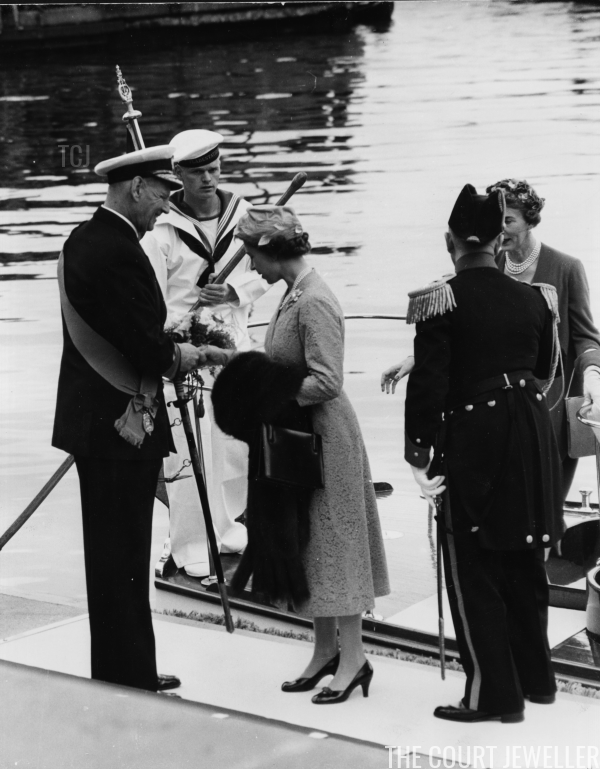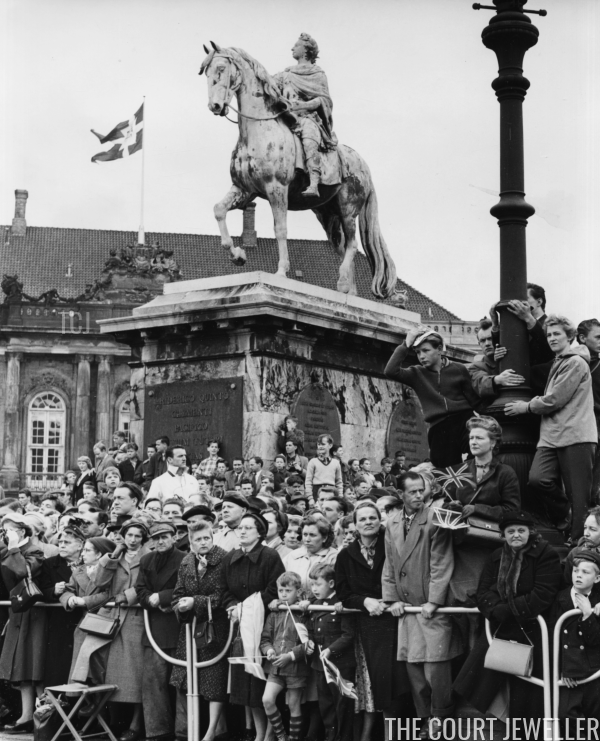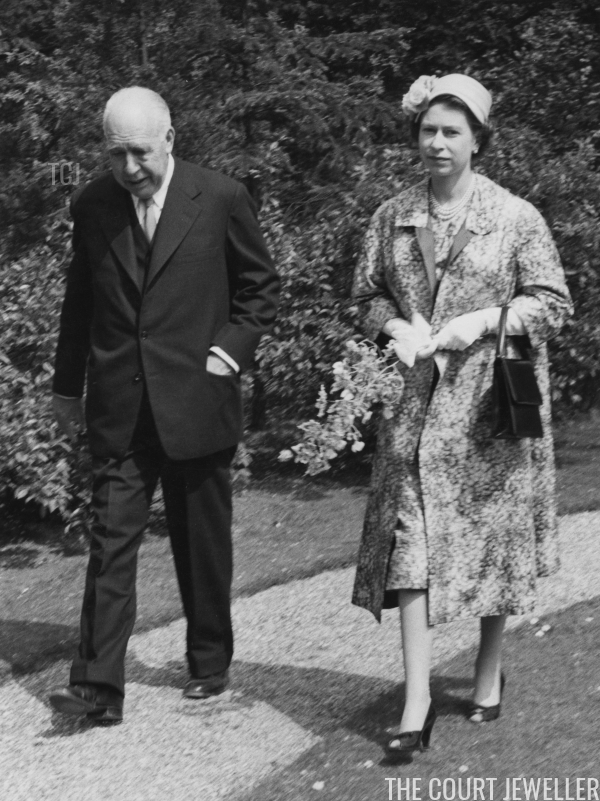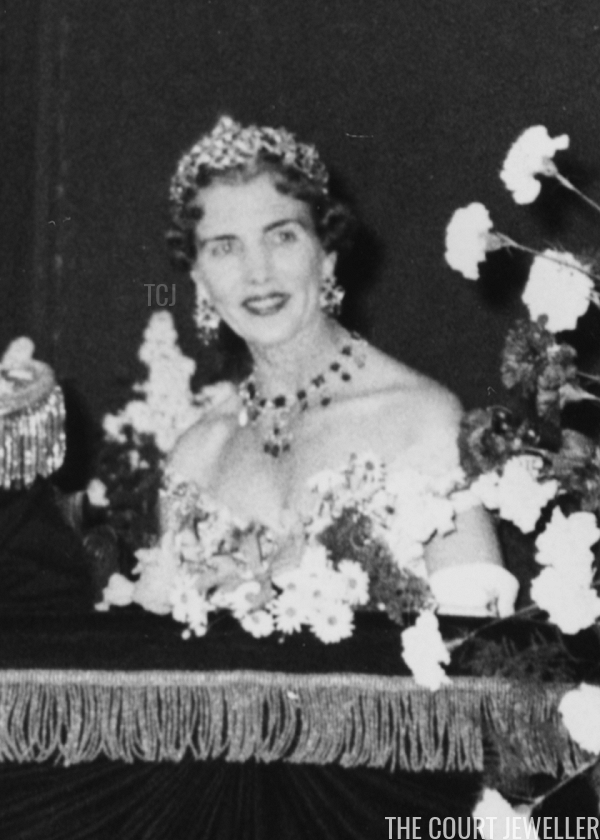 |
| Derek Berwin/Fox Photos/Getty Images |
Time for another trip in the sparkling royal state visit time machine! This time, we’ve landed in Copenhagen in May 1957, where King Frederik and Queen Ingrid are preparing to roll out the red carpet for their British royal counterparts.
 |
| Queen Elizabeth II, 1957 (Fox Photos/Hulton Archive/Getty Images) |
In May 1957, Queen Elizabeth II of the United Kingdom had just celebrated her 31st birthday. She’d been married for nine years to the Duke of Edinburgh, who was a few weeks shy of turning 36. They had two children: Prince Charles (8) and Princess Anne (6). It was a busy diplomatic year for the Queen and the Duke. They had made a state visit to Portugal in February, and another to France in April; following the state visit to Denmark in May, they would also embark on a lengthy visit to the United States and Canada in the autumn. On the homefront, she was embroiled in the political maneuvering that followed Anthony Eden’s resignation as prime minister following the Suez crisis and the subsequent start of Harold Macmillan’s premiership. In the late summer, an unusual public critique surfaced in the form of Lord Altrincham’s famously pointed essay in the National Review.
 |
| King Frederik IX and Queen Ingrid, 1954 (Willem van de Poll/Nationaal Archief/Wikimedia Commons) |
Across the sea in Denmark, King Frederik IX had recently celebrated his 58th birthday. He’d been on the Danish throne for a decade, coming to power shortly after the traumatic war years of occupation in his country, during which he’d also served as regent for his ailing father. He and 47-year-old Queen Ingrid celebrated their 22nd wedding anniversary during the British visit. They had three daughters: Princess Margrethe (17), the heir to the throne; Princess Benedikte (13); and Princess Anne-Marie (10). Queen Ingrid, who was the daughter of King Gustaf VI Adolf of Sweden, was also a member of the extended British royal family. Her mother, Princess Margaret of Connaught, was a granddaughter of Queen Victoria and a niece of King Edward VII, making her a cousin of Queen Elizabeth II. The Duke of Edinburgh was also connected to both Frederik and Ingrid; Philip’s father was a Danish royal descendant, and his aunt, Queen Louise of Sweden, was Ingrid’s stepmother. And, of course, Queen Elizabeth had Danish royal heritage, too: the Danish-born Queen Alexandra was her great-grandmother.

The state visit began on Tuesday, May 21, 1957. The Queen and the Duke of Edinburgh sailed into Copenhagen aboard the Britannia. As they arrived, they were greeted with a 21-gun salute from Kronborg Castle (made famous as Hamlet’s “Elsinore” by Shakespeare); the Danish Royal Air Force also paid tribute by forming an “E” with their aircraft in the skies above. Once Britannia had docked, King Frederik and Queen Ingrid sailed out on the Danish royal barge to greet the British royal couple and bring them ashore.
 |
| Derek Berwin/Fox Photos/Getty Images |
When the Queen stepped on to Danish soil, King Frederik charmingly offered her with a bouquet himself. The Guardian described her ensemble for the arrival as “a pale blue slim-fitting coat dress in embroidered lace and a small cloche hat in matching silk with feathers,” adding that even though “the sky was grey and the wind cool…the Queen carried her coat over her arm.”
 |
| Keystone Press/Alamy |
On her blue lace dress, the Queen pinned one of her most magnificent jewels: the Williamson Pink Diamond Brooch. She also wore four strands of pearls rather than her typical three, as well as (I think) Queen Victoria’s Diamond Stud Earrings.

Queen Ingrid and the Duke of Edinburgh followed the monarchs out of the royal barge and on to the dock. You’ll note that Queen Ingrid wore one of her floral brooches for the welcome ceremonies.

Numerous members of the Danish royal family awaited the British royals as they arrived. One of them in particular was an extremely familiar face: Princess Anne, wife of Prince George of Denmark. (She’s closest to the camera here.) Born Anne Bowes-Lyon, she was a niece of the Queen Mother, and therefore a first cousin of Queen Elizabeth II. Following the end of her first marriage to Viscount Anson (with whom she had two children, the photographer Patrick Lichfield and the events planner Lady Elizabeth Anson), she had married Prince George of Denmark (son of Prince Axel and Princess Margaretha) at Glamis Castle in 1950.

Also happy to greet the royal couple was the young Princess Margrethe, the 17-year-old heir to the Danish throne. This state visit was one of Margrethe’s first formal state occasions. She’s the one in the hat curtseying to the Queen in the image above.
Several other members of the extended family were present, too. In this image, you’ll be able to identify Hereditary Prince Knud and Hereditary Princess Caroline-Mathilde (brother and sister-in-law of King Frederik); Princess Margrethe (daughter of the king); Prince Axel and Princess Margaretha (cousins of the king); Princess Margrethe of Bourbon-Parma (cousin of the king); Princess Elisabeth and Prince Ingolf (niece and nephew of the king); and Princess Viggo (cousin by marriage of the king). Prince Axel and Princess Margaretha were also the in-laws of King Olav V of Norway and King Leopold III of Belgium; Princess Margrethe of Bourbon-Parma was the mother of Queen Anne of Romania.

After greeting members of the royal family, King Frederik and Queen Elizabeth rode in a carriage through the streets of Copenhagen to the Amalienborg Palace complex. Behind them, Queen Ingrid, Prince Philip, and Princess Margrethe rode in a second carriage. (This was young Margrethe’s first royal procession, too.)
 |
| Derek Berwin/Fox Photos/Getty Images |
All along the route, the royals were cheered by gathered crowds. Ahead of the visit, some members of the press speculated that the British royals might not receive a particularly warm response from the Danes. Reuters reported, “Rightly or wrongly, the Danes feel that Britain, their main customer for their dairy product exports, is letting them down both in trade principle and trade practice on the world market, and thereby threatening Danish farming with ruin.” But, given the size of the crowds and their cheers, the Danes who gathered in Copenhagen on the first day of the visit were more approving of the visiting heads of state than expected.

Indeed, the cheers from the crowds in the square outside the palace were so loud that both royal couples obliged them with an appearance on the balcony of the Christian VII Palace. Members of the crowd shouted “Elizabeth!” to summon the visiting monarch, who waved alongside her Danish counterpart.
Inside the palace, the Queen and the Duke of Edinburgh posed with King Frederik, Queen Ingrid, and their daughters for a set of formal photos.
 |
| Derek Berwin/Fox Photos/Getty Images |
Next, the royals traveled to Ryvangen Memorial Park in Copenhagen, where they visited a memorial to the 197 heroes who died in the Danish resistance movement during the war. The memorial also commemorates the lives of Danes who died in concentration camps.
 |
| Derek Berwin/Fox Photos/Getty Images |
The Queen laid a wreath at the memorial during her visit to the park. Later, King Frederik and Prince Philip, who were both naval officers, traveled together to lay another wreath at a memorial to the Danish sailors who perished in the war.
 |
| PA Images/Alamy |
After a round of diplomatic meetings, it was time for the spotlight event of the evening: the grand state banquet at Christiansborg Palace. Both queens wore important diamond and pearl jewels for the dinner.
 |
| PA Images/Alamy |
Queen Elizabeth reached for a favorite state banquet jewelry combination of hers: the Vladimir Tiara, the Gloucester Pendant Earrings, and Queen Victoria’s Golden Jubilee Necklace. She secured the sash of the Order of the Elephant with the Kensington Bow Brooch, and added one of Queen Mary’s Chain-Link Bracelets to her right wrist.
 |
| PA Images/Alamy |
Queen Ingrid dazzled in the grand Pearl Poire Tiara, but rather than pairing it with its usual accompanying jewels, she added diamonds instead. She wore the long diamond earrings, necklace, and devant de corsage from the Danish crown jewel collection. You can see the pieces as they are usually displayed at Rosenborg Castle in our tour of the exhibition here!
 |
| Hulton Archive/Getty Images |
The state banquet was a dazzling affair held in the grand banqueting hall at Christiansborg Palace. Guests dined using solid gold tableware, and King Frederik and Queen Elizabeth gave the usual speeches. But one thing about this banquet, and indeed the entire first day of the visit, was very unusual indeed. For the first time, the Danish television service made a direct broadcast to Britain, showing the arrival, the carriage procession, and the state banquet. The Guardian‘s television critic was mildly complimentary of the broadcast, noting, “With much less experience than the BBC of handling these royal occasions, it had a much less professional touch, but still gave quite a good account of itself.” Commentary for British viewers was provided by Richard Dimbleby, the most important BBC broadcaster of the era (and father of broadcasters David and Jonathan Dimbleby).

The second day of the state visit (Wednesday, May 22, 1957) began with a tour of Carlsberg Brewery. Unfortunately for HM, the Age reported that “to avoid any risk of offending any sections of the British public, the brewery did not offer the Queen any beer.”
 |
| Fox Photos/Hulton Archive/Getty Images |
While on the brewery campus, the Queen also met with famed Danish physicist Niels Bohr, who was residing in Carlsberg’s House of Honor. (Fun fact: one of the perks of the house was a direct tap line to the brewery, offering Bohr and his wife free beer whenever they wanted!) It may seem odd that a beer brewing company would offer a residence to a scientist, but it was all part of Carlsberg’s commitment to scientific endeavors. They didn’t just brew beer; they developed a laboratory to make strides in the science of brewing. They also sponsored the Carlsberg Foundation, which supported many academic causes in Denmark.
It’s pretty tough to see in most photos (and completely hidden here), but I believe the Queen wore the Women of Hampshire Brooch for the morning engagements on the second day of the visit. Queen Ingrid’s brooch is easier to spot: it’s her Diamond Daisy Brooch, set with diamonds that belonged to the late Margaret of Connaught.

After the brewery tour, the royal party visited a nursery school in Copenhagen and had lunch at Amalienborg Palace. In the afternoon, Queen Elizabeth and Prince Philip attended a large reception for Commonwealth citizens at the Freemasons’ Hall. More than 1500 people were in attendance, including numerous representatives of various Anglo-Danish societies.
 |
| Derek Berwin/Fox Photos/Getty Images |
In the evening, tiaras were brought out once more for another gala occasion. This time, the royals were celebrated with a gala performance of ballet at the Royal Theatre in Copenhagen. King Frederik, Queen Ingrid, Queen Elizabeth, and Prince Philip were seated in the royal box for the performance, with other members of the Danish royal family also in prominent seats nearby. (Princess Margrethe attended this performance, but as she was not yet eighteen, she didn’t wear a tiara.)
 |
| Derek Berwin/Fox Photos/Getty Images |
For this occasion, Queen Elizabeth reached into her jewelry box for pieces that had belonged to her Danish royal great-grandmother, Queen Alexandra. She wore Queen Alexandra’s Kokoshnik with the Greville Chandelier Earrings. She also made a rare appearance in the Dagmar Necklace, made by Danish jeweler Julius Dideriksen in 1863. It was a wedding present to Queen Alexandra from King Frederik VII of Denmark, who had chosen Alexandra’s father, Christian IX, to be his successor. The large necklace is made of diamonds and pearls set in gold, and in its complete form, it features a large Byzantine cross pendant, which is a replica of the famous Dagmar Cross. The Queen has always worn the necklace without the cross, and for this appearance, she also removed two of the largest pearl pendants. (The Queen’s Diamonds has an excellent section on the Dagmar Necklace with fantastic photos.)
 |
| Derek Berwin/Fox Photos/Getty Images |
Queen Ingrid also wore jewels with important Danish royal heritage, donning the tiara, necklace, and earrings from the Danish Emerald Parure for the ballet performance. As they positively dripped in jewels, the royals and other concert attendees enjoyed a program featuring extracts from ballets by Vittorio Rieti and August Bournonville.
The third and final day of the state visit (Thursday, May 23, 1957) began with a church visit. The Queen and the Duke headed to St. Alban’s Church in Copenhagen, an Anglican church that is often referred to by locals simply as “the English church.”
 |
| PA Images/Alamy |
For the third day’s events, the Queen reached for another jewel with Danish royal ties. Empress Marie Feodorovna’s Sapphire Brooch, with its distinctive pearl pendant, was purchased by Queen Mary from the estate of the late Russian tsarina in 1930. Marie Feodorovna, who was Queen Alexandra’s sister, was born Princess Dagmar of Denmark, one of the daughters of King Christian IX.

One of the highlights of the final day of the visit was a trip to the Royal Porcelain Factory, better known as Royal Copenhagen. The Queen appeared to be delighted as she watched the company’s artists paint delicate pieces of china. During the visit, she was presented with a set of ten figurines of children in folk costumes.
Here’s a color photo from the Royal Copenhagen stop, showing the lovely blue color of the Queen’s outfit and hat.
The royals made a stop at the family’s hunting lodge, Eremitagen, for lunch before a reception at the Town Hall in Copenhagen. The day finished with a private party on board Britannia, but the British royals didn’t return home right away. Instead, they stayed on for another two days at Fredensborg Castle for a private visit with their royal relatives, before sailing back to Scotland on the royal yacht.
Leave a Reply